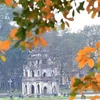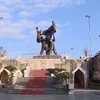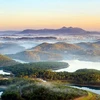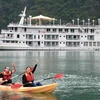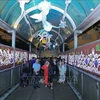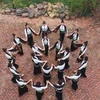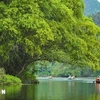Have you ever seen thousands of big fish swimming in a small stream? How would you feel if you knew that these fish were magic? In Thanh Hoa Province's Cam Luong Commune it is believed that such a school of ‘sacred fish' exists and they can be visited by the public.
It takes about three hours to drive from Hanoi to the famous commune, which receives thousands of visitors every week who are curious to see these supernatural species.
There are different ways to get to the stream. From Thanh Hoa city, people can drive on the National Highway to reach Cam Thuy district and then drive on Highway 217 for 12km to Ngoc Village, which is home to the fish. For more adventurous travellers, they can catch a boat at the Ham Rong Bridge and sail along Ma River to get to the village.
Buses are unable to drop visitors off at the cave because it is on the other side of the Ma River. All visitors must then load up into small cars and they are then driven over a wooden suspension bridge to get to the opposite bank near the entrance of the cave.
The stream that is home to the ‘sacred fish' is about 100m long and up to 4m wide. The water in the stream is clear, clean and stays cool year-round.
Thousands of fish swam around like it was recess. The smallest fish were probably 2kg and the larger ones were probably closer to 10kg.
"The fish here are very friendly. In the past, when not so many people visited, we often played with them," said Ha Thi Sau, a local resident.
"The stream is our main source of water. We take water from here for washing, cooking and bathing. Despite our daily presence, the fish are still not afraid of us. We often touch and fondle them like our pets, and I think that they also like us," she said.
The fish are biologically related to minnows and carp. The rare species are found in Laos , northern Vietnam and southern China . They are also listed in Vietnam 's Red Book because the species are on the verge of becoming extinct. The fish have a dark back and red lips and fins. They also have red-spotted tails and silver scales that glisten in the sunlight.
"They eat almost everything that they find in the stream, including moss, leaves and vegetables that we give them," said Sau.
"Since the tourists know about the stream, the visitors rush to our village and bring popcorn, candy and snacks. These items are also feed to the fish, but the tourists also throw trash into the water, which makes it polluted," the 86-year-old women said.
The stream and ‘sacred fish' have been popular in the area for years, but they first became popular with the wider public in 1994.
Although many things have changed in the last few years and thousands of tourists have come to see them, the fish still keep their natural routine intact. The sacred species swim out of the cave early in the morning to look for food and play with people before coming back to the cave at 5 or 6pm.
"The fish never swim outside of the stream, which runs into the Ma River. Sometimes the fish are swept away, but they always try to swim back to the cave."
Because the local people dare not to catch and eat these fish, the population is now thriving and growing.
"We believe that they bring us luck and happiness so we have never considered eating them," said Sau.
On the 8th-15th during the first month of the lunar calendar, the village hosts a gigantic festival. At the event, the local people offer sacrifices to the gods of the mountains, river and fish.
"A board has been set up to manage the venue and protect the fish, but we do not have to do much because the local residents are awarded the profits and receive luck from the fish bring to them," said Vu Duyen Hong, the director of the Cam Thuy district's Culture and Sport Centre which runs the management board.
"What we have to do is to make sure our guests do not do anything that would harm the fish and maintain a good environment for the ‘sacred' animals," he said./.
It takes about three hours to drive from Hanoi to the famous commune, which receives thousands of visitors every week who are curious to see these supernatural species.
There are different ways to get to the stream. From Thanh Hoa city, people can drive on the National Highway to reach Cam Thuy district and then drive on Highway 217 for 12km to Ngoc Village, which is home to the fish. For more adventurous travellers, they can catch a boat at the Ham Rong Bridge and sail along Ma River to get to the village.
Buses are unable to drop visitors off at the cave because it is on the other side of the Ma River. All visitors must then load up into small cars and they are then driven over a wooden suspension bridge to get to the opposite bank near the entrance of the cave.
The stream that is home to the ‘sacred fish' is about 100m long and up to 4m wide. The water in the stream is clear, clean and stays cool year-round.
Thousands of fish swam around like it was recess. The smallest fish were probably 2kg and the larger ones were probably closer to 10kg.
"The fish here are very friendly. In the past, when not so many people visited, we often played with them," said Ha Thi Sau, a local resident.
"The stream is our main source of water. We take water from here for washing, cooking and bathing. Despite our daily presence, the fish are still not afraid of us. We often touch and fondle them like our pets, and I think that they also like us," she said.
The fish are biologically related to minnows and carp. The rare species are found in Laos , northern Vietnam and southern China . They are also listed in Vietnam 's Red Book because the species are on the verge of becoming extinct. The fish have a dark back and red lips and fins. They also have red-spotted tails and silver scales that glisten in the sunlight.
"They eat almost everything that they find in the stream, including moss, leaves and vegetables that we give them," said Sau.
"Since the tourists know about the stream, the visitors rush to our village and bring popcorn, candy and snacks. These items are also feed to the fish, but the tourists also throw trash into the water, which makes it polluted," the 86-year-old women said.
The stream and ‘sacred fish' have been popular in the area for years, but they first became popular with the wider public in 1994.
Although many things have changed in the last few years and thousands of tourists have come to see them, the fish still keep their natural routine intact. The sacred species swim out of the cave early in the morning to look for food and play with people before coming back to the cave at 5 or 6pm.
"The fish never swim outside of the stream, which runs into the Ma River. Sometimes the fish are swept away, but they always try to swim back to the cave."
Because the local people dare not to catch and eat these fish, the population is now thriving and growing.
"We believe that they bring us luck and happiness so we have never considered eating them," said Sau.
On the 8th-15th during the first month of the lunar calendar, the village hosts a gigantic festival. At the event, the local people offer sacrifices to the gods of the mountains, river and fish.
"A board has been set up to manage the venue and protect the fish, but we do not have to do much because the local residents are awarded the profits and receive luck from the fish bring to them," said Vu Duyen Hong, the director of the Cam Thuy district's Culture and Sport Centre which runs the management board.
"What we have to do is to make sure our guests do not do anything that would harm the fish and maintain a good environment for the ‘sacred' animals," he said./.
